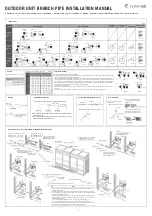
Sequence of Operation
RT-SVX26R-EN
45
and remains there for a few minutes, the unit will begin to
stage up compressors. If the supply fan is on when the first
stage compressor is energized, it will remain energized or
energize at low speed for the duration of Cool 1. When
there is a call for Cool 2, the second compressor is
energized and the Supply Fan will switch to High Speed.
Note:
For 3-step cool units the unit will utilize Low Fan
Speed during requests for Cool 1 and Cool 2 during
cooling operation. High Fan Speed will be used
only for Cool 3.
The unit will stage down compressors for cooling in
reverse order that they were staged and the supply fan will
follow the unit mode transitions. Once it is determined
through normal cooling control that the second
compressor is no longer necessary to meet cooling
demand, the second compressor will be staged back and
the supply fan will switch to Low Speed until the unit
stages all cooling off or receives a call for Cool 2 again.
Once the Supply Fan is no longer requested ON after a
Cooling call is cleared, the Supply Fan will remain
energized at Low Speed for 60 seconds as on traditional
units.
For units under thermostat control, if the economizer is
enabled and is being utilized as the first stage of cooling
(Y1 active), if the unit receives a Y2 request, the unit will
energize the first compressor and will switch the supply
fan to high speed until the Y2 request is cleared.
Economizer Minimum Position Handling
for 2-Speed Fan
Due to the low and high speeds of the indoor fan, when the
unit is in Fan Only, Cool 1, or Economizer Only and the
indoor fan is at low speed, the unit will not be bringing in
as much fresh air as normal. By setting a higher minimum
damper position this problem could be solved, but that
would mean more fresh air than may be desired when the
supply fan is at high speed. To overcome these situations,
the control will require the setting of two economizer
minimum positions to be used when the fan is at low and
high speed to compensate for the lower amount of fresh
air at lower fan speeds and the potential for more fresh air
than desired at higher fan speeds. These minimum
positions will be obtained from the Bldg Design Min
Position and DCV Min Position pots on the RTEM. The
economizer minimum position that will be utilized while
the supply fan is at low speed will be set with the DCV Min
Position pot with a range of 0-100% and the minimum
position that will be utilized while the supply fan is at high
speed will be set with the Building Design Min Position pot
with a range of 0-50%. If the Building Design Min Position
is set to be higher than the DCV Min Position, the setpoints
will be capped at the DCV Min Position and the setpoint for
the min position at low and high fan speed will be the DCV
Min Position.
Demand Controlled Ventilation Operation
Demand Controlled Ventilation for units with 2-Speed
Supply Fans will require an additional module (RTVM) for
the 2 additional setpoint potentiometers necessary in
order to overcome the non-linear characteristics of the
airflow through the outside air damper along with the
multiple supply fan speeds.
The new Demand Controlled Ventilation scheme will
require the user to select 4 OA Damper Minimum Position
setpoints in addition to the Design and DCV CO2 Setpoints:
1. Design Min Position @ Low Fan Speed Command
(RTVM R130)
2. Design Min Position @ High Fan Speed Command
(RTEM Design Min)
3. DCV Min Position @ Low Fan Speed Command (RTVM
R41)
4. DCV Min Position @ High Fan Speed Command (RTEM
DCV Min)
The speed at which the Supply Fan operates will dictate
which Design and DCV Minimum Position setpoint is used
in the calculation for the OA Damper Minimum Position
Target for Demand Controlled Ventilation. All other
functionality for Demand Controlled Ventilation will
operate as on traditional units.
Low Ambient Operation on Units with 2-
Speed Indoor Fan
The indoor fan motor (IDM) will continue to operate at
100% fan speed during this evaporator defrost cycle (EDC)
and the compressor and outdoor fan will return to normal
operation once the defrost cycle has terminated and the
compressor “Off” time delay has been satisfied.
Heating Operation
Standard unit operation for heating will continue on units
equipped with a two-speed indoor fan. During heat mode,
all units configured with gas heat, modulating gas heat,or
reheat/dehumidification will heat and reheat/dehumidify
the supply air and space as normal utilizing full speed
indoor fan by energizing the RTRM supply fan output.
Failure and Override Modes
•
Supply Fan Proving - If there is a supply fan failure
condition all outputs associated with the supply fan
output control will be de-energized.
•
Ventilation Override Mode - For all VOM modes that
require supply fan operation (Purge and Pressurize),
the supply fan will operate at high speed.
•
All failure modes that require the Supply Fan to
operate, the Supply Fan will energize at high speed. For
instance if the Frostat switch closes, the Supply Fan will
operate at high speed.
















































